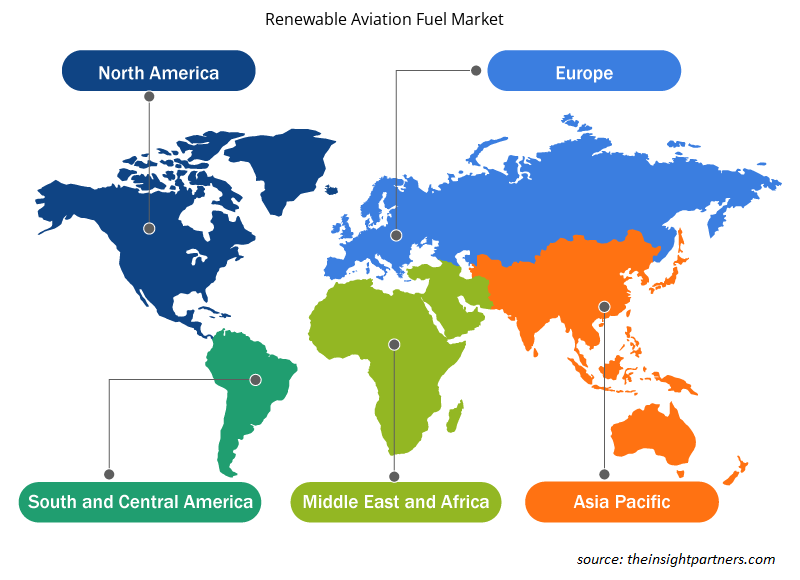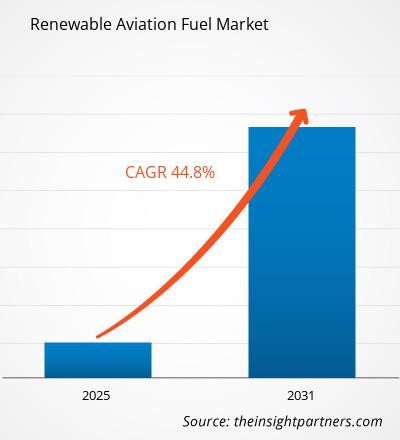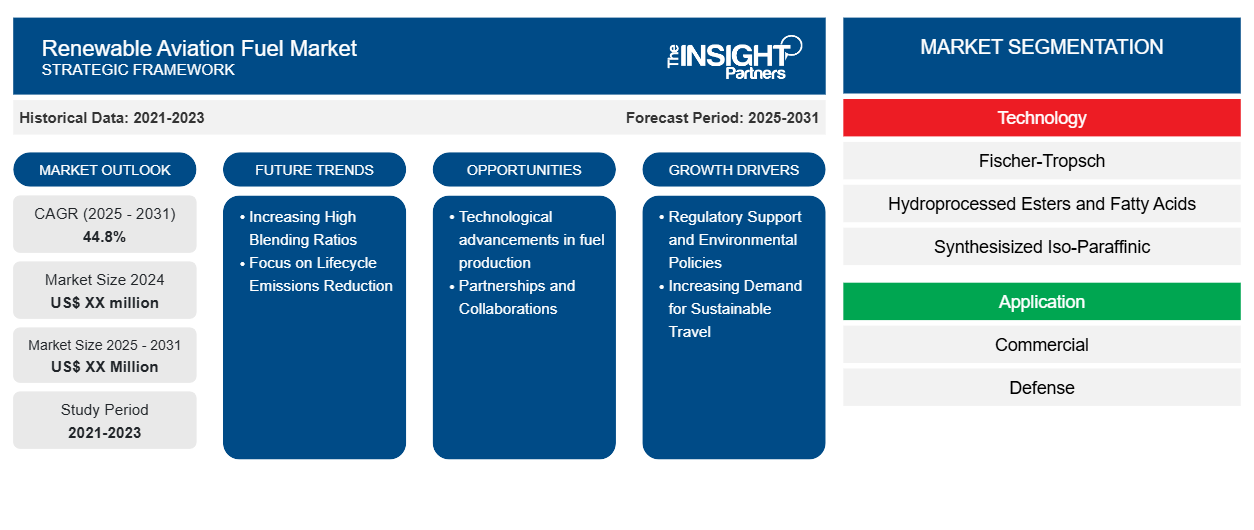Si prevede che il mercato del carburante rinnovabile per l'aviazione registrerà un CAGR del 44,8% dal 2023 al 2031, con una dimensione di mercato in espansione da XX milioni di dollari USA nel 2023 a XX milioni di dollari USA entro il 2031.
Il rapporto è segmentato per tecnologia (Fischer-Tropsch (FT), esteri idroprocessati e acidi grassi (HEFA), isoparaffinici sintetizzati (SIP), Alcohol-to-Jet (AJT)). Il rapporto presenta inoltre analisi basate sull'applicazione (commerciale, difesa). L'analisi globale è ulteriormente suddivisa a livello regionale e nei principali paesi. Il rapporto offre il valore in USD per l'analisi e i segmenti di cui sopra.
Scopo del rapporto
Il report Renewable Aviation Fuel Market di The Insight Partners mira a descrivere il panorama attuale e la crescita futura, i principali fattori trainanti, le sfide e le opportunità. Ciò fornirà spunti a vari stakeholder aziendali, come:
- Fornitori/produttori di tecnologia: per comprendere le dinamiche di mercato in evoluzione e conoscere le potenziali opportunità di crescita, consentendo loro di prendere decisioni strategiche informate.
- Investitori: condurre un'analisi completa delle tendenze in merito al tasso di crescita del mercato, alle proiezioni finanziarie del mercato e alle opportunità esistenti lungo la catena del valore.
- Enti di regolamentazione: regolamentano le politiche e le attività di controllo sul mercato allo scopo di ridurre al minimo gli abusi, preservare la fiducia degli investitori e sostenere l'integrità e la stabilità del mercato.
Segmentazione del mercato del carburante rinnovabile per l'aviazione
Tecnologia
- Fischer Tropsch
- Esteri e acidi grassi idrotrattati
- Iso-paraffinico sintetizzato
- Alcol-a-Jet
Applicazione
- Commerciale
- Difesa
Personalizza questo report in base alle tue esigenze
Riceverai la personalizzazione gratuita di qualsiasi report, comprese parti di questo report, o analisi a livello nazionale, pacchetto dati Excel, oltre a usufruire di grandi offerte e sconti per start-up e università
- Scopri le principali tendenze di mercato in questo rapporto.Questo campione GRATUITO includerà analisi di dati che spaziano dalle tendenze di mercato alle stime e alle previsioni.
Fattori trainanti della crescita del mercato del carburante rinnovabile per l'aviazione
- Supporto normativo e politiche ambientali: i governi di tutto il mondo stanno applicando rigide politiche di regolamentazione che includono la riduzione delle emissioni di carbonio attraverso l'aviazione. Ciò significa che tale supporto normativo sta spingendo delicatamente verso l'implementazione di carburante per l'aviazione rinnovabile, poiché le compagnie aeree seguono tali obiettivi sostenibili e riducono la loro impronta ecologica. Un'alternativa ecologica è ora imperativa per essere una caratteristica critica all'interno della strategia e dell'approccio delle industrie verso stili di vita sostenibili.
- Domanda crescente di viaggi sostenibili: con la crescente domanda dei consumatori di opzioni di viaggio sostenibili, anche le compagnie aeree sono spinte a investire in carburanti per l'aviazione rinnovabili. Man mano che il viaggiatore diventa più attento all'ambiente, le compagnie aeree rispondono in diversi modi includendo carburanti per l'aviazione sostenibili nelle loro operazioni per migliorare l'immagine del loro marchio e soddisfare le aspettative dei clienti per soluzioni di viaggio ecologiche.
Tendenze future del mercato del carburante rinnovabile per l'aviazione
- Aumento di elevati rapporti di miscelazione: tuttavia, un'altra tendenza significativa nel carburante per aviazione rinnovabile è quella di aumentare i rapporti di miscelazione di carburanti per aviazione sostenibili con carburanti per jet convenzionali. Ciò è guidato sia dallo sviluppo tecnologico sia dagli incentivi delle normative per muoversi verso rapporti di miscelazione più elevati. Oltre a ciò, esiste il potenziale per una crescita verso rapporti di sostituzione più elevati di carburanti rinnovabili rispetto ai carburanti per jet convenzionali.
- Focus sulla riduzione delle emissioni del ciclo di vita: il settore ha iniziato a concentrarsi sulle emissioni del ciclo di vita dei carburanti per l'aviazione, dalla produzione al livello di consumo, quando si tratta di sostenibilità e impatto ambientale minimo della produzione di carburanti rinnovabili. La tendenza completa alla riduzione delle emissioni del ciclo di vita stabilisce la direzione per la produzione e la commercializzazione di carburanti per l'aviazione rinnovabili.Lifecycle Emissions Reduction: The industry has begun to focus on lifecycle emissions of aviation fuels-from the production to the consumption level-when it comes to the sustainability and minimal environmental impact of producing renewable fuels. The complete lifecycle emissions reduction trend sets the direction for the production and marketing of renewable aviation fuels.
Opportunità di mercato per il carburante rinnovabile per l'aviazione
- Progressi tecnologici nella produzione di carburante: le prospettive di questo mercato sono in aumento poiché i progressi tecnologici nei processi di conversione delle materie prime e la scoperta di nuovi percorsi per la sintesi dei carburanti possono aumentare l'efficienza e ridurre i costi di produzione dei RAF, migliorando così la posizione competitiva dei RAF rispetto ai tradizionali carburanti per aerei.
- Partnership e collaborazioni: potrebbero esserci opportunità per compagnie aeree, produttori di carburante e istituti di ricerca di collaborare per uno sviluppo e un'implementazione più rapidi di carburanti per l'aviazione rinnovabili. Le partnership strategiche possono consentire la condivisione reciproca delle conoscenze, gli investimenti in R&S e l'istituzione di catene di fornitura per incoraggiare l'adozione diffusa di RAF in tutto il settore.
Approfondimenti regionali sul mercato del carburante per l'aviazione rinnovabile
Le tendenze regionali e i fattori che influenzano il mercato del carburante per l'aviazione rinnovabile durante il periodo di previsione sono stati ampiamente spiegati dagli analisti di Insight Partners. Questa sezione discute anche i segmenti e la geografia del mercato del carburante per l'aviazione rinnovabile in Nord America, Europa, Asia Pacifico, Medio Oriente e Africa e America meridionale e centrale.

- Ottieni i dati specifici regionali per il mercato del carburante rinnovabile per l'aviazione
Ambito del rapporto sul mercato del carburante per l'aviazione rinnovabile
| Attributo del report | Dettagli |
|---|---|
| Dimensioni del mercato nel 2023 | XX milioni di dollari USA |
| Dimensioni del mercato entro il 2031 | XX milioni di dollari USA |
| CAGR globale (2023-2031) | 44,8% |
| Dati storici | 2021-2022 |
| Periodo di previsione | 2024-2031 |
| Segmenti coperti | Per tecnologia
|
| Regioni e Paesi coperti | America del Nord
|
| Leader di mercato e profili aziendali chiave |
|
Densità degli operatori del mercato del carburante rinnovabile per l'aviazione: comprendere il suo impatto sulle dinamiche aziendali
Il mercato del carburante per l'aviazione rinnovabile sta crescendo rapidamente, spinto dalla crescente domanda degli utenti finali dovuta a fattori quali l'evoluzione delle preferenze dei consumatori, i progressi tecnologici e una maggiore consapevolezza dei vantaggi del prodotto. Con l'aumento della domanda, le aziende stanno ampliando le loro offerte, innovando per soddisfare le esigenze dei consumatori e capitalizzando sulle tendenze emergenti, il che alimenta ulteriormente la crescita del mercato.
La densità degli operatori di mercato si riferisce alla distribuzione di aziende o società che operano in un particolare mercato o settore. Indica quanti concorrenti (operatori di mercato) sono presenti in un dato spazio di mercato in relazione alle sue dimensioni o al valore di mercato totale.
Le principali aziende che operano nel mercato del carburante rinnovabile per l'aviazione sono:
- Emete
- Amiri
- Società per azioni Avfuel
- Sistemi di alimentazione Ballard.
- società a responsabilità limitata
Disclaimer : le aziende elencate sopra non sono classificate secondo un ordine particolare.

- Ottieni una panoramica dei principali attori del mercato del carburante rinnovabile per l'aviazione
Punti di forza chiave
- Copertura completa: il rapporto esamina in modo completo i prodotti, i servizi, le tipologie e gli utenti finali del mercato del carburante rinnovabile per l'aviazione, offrendo una panoramica olistica.
- Analisi degli esperti: il rapporto è compilato sulla base della conoscenza approfondita di esperti e analisti del settore.
- Informazioni aggiornate: il rapporto garantisce la pertinenza aziendale grazie alla copertura di informazioni recenti e tendenze nei dati.
- Opzioni di personalizzazione: questo report può essere personalizzato per soddisfare le esigenze specifiche del cliente e adattarsi in modo appropriato alle strategie aziendali.
Il rapporto di ricerca sul mercato del carburante per l'aviazione rinnovabile può, quindi, aiutare a guidare il percorso di decodifica e comprensione dello scenario del settore e delle prospettive di crescita. Sebbene possano esserci alcune preoccupazioni valide, i vantaggi complessivi di questo rapporto tendono a superare gli svantaggi.
- Analisi storica (2 anni), anno base, previsione (7 anni) con CAGR
- Analisi PEST e SWOT
- Valore/volume delle dimensioni del mercato - Globale, Regionale, Nazionale
- Industria e panorama competitivo
- Set di dati Excel
Report recenti
Testimonianze
Motivo dell'acquisto
- Processo decisionale informato
- Comprensione delle dinamiche di mercato
- Analisi competitiva
- Analisi dei clienti
- Previsioni di mercato
- Mitigazione del rischio
- Pianificazione strategica
- Giustificazione degli investimenti
- Identificazione dei mercati emergenti
- Miglioramento delle strategie di marketing
- Aumento dell'efficienza operativa
- Allineamento alle tendenze normative























 Ottieni un campione gratuito per - Mercato del carburante rinnovabile per l'aviazione
Ottieni un campione gratuito per - Mercato del carburante rinnovabile per l'aviazione